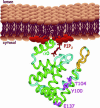There's a GAP in the ENTH domain
- PMID: 16537466
- PMCID: PMC1449625
- DOI: 10.1073/pnas.0600658103
There's a GAP in the ENTH domain
Conflict of interest statement
Conflict of interest statement: No conflicts declared.
Figures


Comment on
-
Epsin N-terminal homology domains perform an essential function regulating Cdc42 through binding Cdc42 GTPase-activating proteins.Proc Natl Acad Sci U S A. 2006 Mar 14;103(11):4116-21. doi: 10.1073/pnas.0510513103. Epub 2006 Mar 6. Proc Natl Acad Sci U S A. 2006. PMID: 16537494 Free PMC article.
References
Publication types
MeSH terms
Substances
LinkOut - more resources
Full Text Sources
Molecular Biology Databases
Miscellaneous

